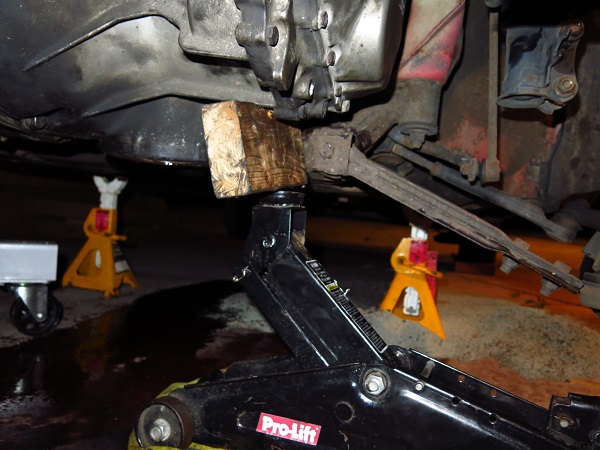Mating the transmission to the engine is easy when they're not inside the vehicle. Or when they're underneath a 40-year-old flatbed. Or anywhere else but inside of a subcompact engine bay.
It's really good to have some help with this part. Help can be an awesome transmission jack, a friend, two friends, a wife who used to row and can dead lift the transmission by herself, or whatever. Someone who can hand you things, take them away, and grab the transmission and wiggle, lift a little bit, or push.
Be ready for some frustration. It should be obvious that the ease of installation is directly related to the alignment of the clutch disc, so if you're not sure it's good enough, take the time to make sure it's good enough. Even if it WAS good enough, you're better safe than sorry. What's that woodworker's saying...Measure once, cut twice, then go buy yourself a board stretcher?
Anyway, I plopped the transmission underneath the vehicle and got some "alignment rods" ready. I used a couple old hex keys, but drill rods or center punches could work nicely also. You want something that's pretty close to the inner diameter of the threaded bolt holes. I liked the fact that the hex keys had an angled handle to grab onto. The idea is to lift up the transmission, get it close, align the input shaft, and then start to slide the transmission toward the engine. I started by hand-lifting the transmission. Then we attached a couple ratchet straps to the engine hoist and attached the other ends to a couple holes on the transmission, one of which is actually I think a designed lifting point. Then my special lady put the floor jack under the tail of the transmission. I basically fiddled with the strap and jack until the transmission was aligned as well as I could get it. Then I grabbed the transmission and started sliding it toward the engine.
At first, the input shaft will slide into the center hole in the clutch disc. If this part hangs up, just wiggle the transmission a little bit, or have someone rotate the engine or crankshaft. As it gets closer to the engine block, you can insert the "alignment rods" into one or two holes to keep the holes lined up kind of close, and then when the transmission is about to go together, it's going to get stuck on the dowel sleeves, because they won't be lined up right. Then you're going to wish the clutch plate was aligned better. At this point, if you can get one or two bolts started, do it. You don't want to start prodding the transmission and have it bump completely loose and start to pivot or spin.
When you're at this point, you're fighting two things. The input shaft is lined up in the clutch plate, and the dowel sleeves won't be perfectly aligned with their holes. The ARE slightly tapered at the ends, so they're not completely unforgiving, but you need to be within about 1/8" of the proper alignment.
Odds are good that if you got some bolts started, even just a few threads, that you're good enough to start cinching the two parts together with the rest of the bolts. If not, then you're going to have to use the "alignment rods" to gently pry the housing until it's aligned well enough to get a screw into one of the adjacent holes. Another thing that may help is to have your helper grab the tail end of the transaxle and try to wiggle it or rotate it appropriately.
Don't fight it too hard, though, and try to keep the crankshaft coaxial with the transmission input shaft. You don't want your clutch disc, which is aligned with the transmission input shaft now, to get screwed up. It can take a lot of force (obviously), but it's not designed to take load outside the plane of the disc (like by tilting the transmission).
Be persistent. It shouldn't take too much force to draw the halves together. If it does, and you're cranking on the bolts, slow down, back up, and try again.
Once it's together, everything else should be downhill, so breathe deeply and be happy.




 LinkBack URL
LinkBack URL About LinkBacks
About LinkBacks


 Reply With Quote
Reply With Quote